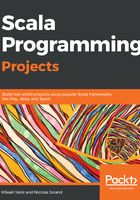
Side effects
A function or expression is said to have a side effect when it modifies some state or has some action in the outside world. For instance, printing a string to the console, writing to a file, and modifying a var, are all side effects.
In Scala, all expressions have a type. A statement which performs a side effect is of type Unit. The only value provided by the type Unit is ():
scala> val x = println("hello")
hello
x: Unit = ()
scala> def printName(name: String): Unit = println(name)
printName: (name: String)Unit
scala> val y = {
var a = 1
a = a+1
}
y: Unit = ()
scala> val z = ()
z: Unit = ()
A pure function is a function whose result depends only on its arguments, and that does not have any observable side effect. Scala allows you to mix side-effecting code with pure code, but it is a good practice to push side-effecting code to the boundaries of your application. We will talk about this later in more detail in the Ensuring referential transparency section in Chapter 3, Handling Errors.
Here is an example of a method call with a side effect where we have to use empty brackets, and an example of a pure function:
scala> def helloWorld(): Unit = println("Hello world")
helloWorld: ()Unit
scala> helloWorld()
Hello world
scala> def helloWorldPure: String = "Hello world"
helloWorldPure: String
scala> val x = helloWorldPure
x: String = Hello world